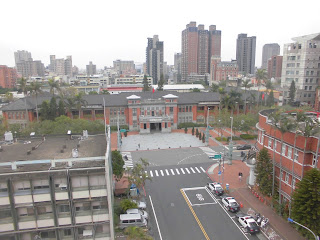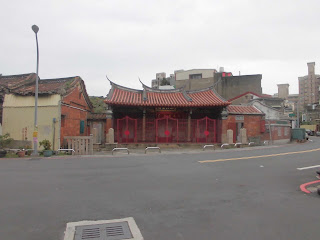今天也是介紹新竹。在市區走路會碰到很多老房子。因爲大部分的是一般的房子而已,所以我沒有想說的事情,只想貼照片而已。
More of Hsinchu. Hsinchu really has a lot of neat old buildings just sitting here and there around town. Most of them are just houses, so I won't necessarily write a lot today. I'll just show you the ones I thought were neat.
新竹の続き。新竹市内を歩けば、簡単に色んな古い建物に出遭える。今日はそういう写真を紹介したいと思うので、文書はたくさん書かない。
古老的消防局。等一下爬上去。
First, here's the old fire station I mentioned in the last post. We'll climb up that soon.
古い消防署。あとでここ登ってみる。
消防局附近的銀行。
A nearby bank.
消防署の近くにあった古そうな銀行。
喵!
Meow!
ニャ〜!
消防局開始爬上。
Here I've started climbing up the tower in the fire station. This fire station was built in the Japanese era, and the tower was so that they could see fires wherever they might spring up around town.
先の消防署を登り始めたところ。
消防局上面有大鐘。
At the top was this large bell.
上にでかい鐘があった。
上面的風景好厲害!
The views from the top.
上の景色すごかった。
下來了。
Back at street level.
また降りてきた。
以前的戲院變成電影博物館。
An old theater that has been turned into a museum of movies.
以前の映画館。今は映画博物館になっている。
喵!
Meow!
ニャ〜!
在影院旁邊有市場。大樓密集,上面看起來都是公寓,一樓都是商店。
Nearby the theater above was this big complex. The upper floors of the buildings are (probably) housing, but the street level is directly connected to the streets outside the complex, and that floor is filled with businesses.
映画館の近くにこの団地があった。上はアパートだと思うけど、一階は全部店になっている。市場みたいな感じになっている。しかも道路と繋がっているので、そのままバイクで入ることができる。
原本黑黑暗暗,再說因爲我下午來了所以商店都在關門,氣氛更寂寞了。
I was here at an odd hour, so everything was shut down and it looked extra grimy and lonely.
午後の微妙な時間帯に来たから、店が全部閉まって暗い感じになっていた。
台灣菸酒局的建築。看起來是日本時代的。
An old Taiwan Tobacco and Liquor building.
台湾タバコと酒局の建物。
旁邊也看起來是日本時代的倉庫,但是很可惜因爲看板太多了所以樣子看不清楚。
The building next door was also an old, Japanese-era storage building, but they covered it up with all of these stupid advertisements, so you can't really see it so well.
隣りに倉庫みたいな建物があって、見た目からすれば多分日本時代のものだと思うが、残念なことに看板がたくさん貼ってあって様子がよく見えない。
這棟房子原本是新竹中學學長的宿舍。是日治時代建的,非常日式的建築。現在變成辛志平學長的博物館。辛志平是中華治時代第一位學長,1945年-1985年住在這棟房子。戰後時代很多日式的建築被破掉了,可是因爲這裡繼續當學長的住宅所以保留下來到現在。
This building was originally built as the residence for the principals of a local high school. It was built during the Japanese era, when all of the principals would have been people from the Japanese mainland, so it's built in a traditional Japanese style. It survived the post-war razing of Japanese style structures because it continued to be used as a house for principals even after the war had ended and the Chinese Nationalists took over Taiwan. It's now been turned into a museum, primarily dedicated to a post-war principal, Hsin Chih-Ping, who lived here from 1945 to 1985.
この和式の家は元々日本時代に建てられたのだ。当時の新竹中学校の校長宿舎だった。戦争が終わって中華民国政府が台湾を支配した時、たくさんの日式建物は壊されてしまったが、ここは校長宿舎としてまだ使われたおかげでそのまま残れた。現在は戦後大一名の校長、辛志平校長、の博物館になっている。彼は1945年-1985年ここに住んでいた。
完全日式
The house is very Japanese.
こんな木材和風の建物は台湾では非常に珍しい。
こんな子もいるかな?(なぜかある店の前にあった。)
這個學校的本館和體育館是日治時代的。
I came to this elementary school to see its old gymnasium and school building, both of which are Japanese period artifacts. (Though still in use!)
日本時代から受け継いだ小学校の校舎と体育館。
附近有眷村的博物館。我到了時已經太晚了關門。
A nearby museum of soldiers' villages. (The villages built for soldiers who came to Taiwan from China after WWII and got stuck here because the Chinese Nationalists lost control of China.)
学校の近くにこの眷村(戦後に中国から渡ってきた兵士のために作られた住宅地のこと)の博物館があった。
A puppet shop. These kinds of traditional puppets used in puppet theater are still decently popular in Taiwan. You can see them performing in front of temples sometimes, and even on TV!
台湾に伝統的な人形劇がある。祭りの時に廟の前によく演技する。テレビにも出ているぐらい人気がある。
夜晚的新竹站
Hsinchu train station at night.
夜の新竹駅
結束!
And that's it for Hsinchu!
はい、終わり!






























































































No comments:
Post a Comment